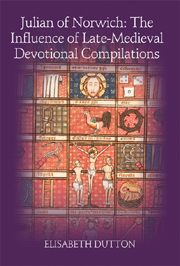3 - Dialogue in Compilation
Published online by Cambridge University Press: 12 September 2012
Summary
It has been shown that some late-fourteenth- and early-fifteenth-century compilation texts are inconsistent in their naming of sources, while the Revelation lacks named sources almost entirely. A named source ties a voice to a particular speaker – where the Speculum, The Chastising and Contemplations do attribute sources, the apparent textual structure is that of a range of authoritative figures, whose words are collected by a consistent compiler figure: the compiler's voice is apparently discernible between the words of his authorities, lexically marked by particular phrases. In fact, as has been shown, the presence of unattributed citations alongside attributed ones, and the manipulation of citations within context, ensure that this structure is not as transparent as it might appear – nevertheless it is the structural principle which the reader experiences.
The Revelation, by contrast, puts words into the mouths of two interlocutors – Christ and Julian. Both interlocutors, in acts of compilation, appropriate words which may have biblical, liturgical or other sources – or which may have the appearance of such sources – and use them in dialogue. Similarly, the narrator of the Revelation, the extra-textual Julian, engages with the words of Christ or the words of the Julian within the text. Thus the Revelation draws together its range of ventriloquisms into a dialogic text, structured around dialogue between Christ and the Julian who receives the visions, or the interrogation of the moment of vision by the narrator recording revelation at a considerable historical remove.
- Type
- Chapter
- Information
- Julian of NorwichThe Influence of Late-Medieval Devotional Compilations, pp. 86 - 122Publisher: Boydell & BrewerPrint publication year: 2008



